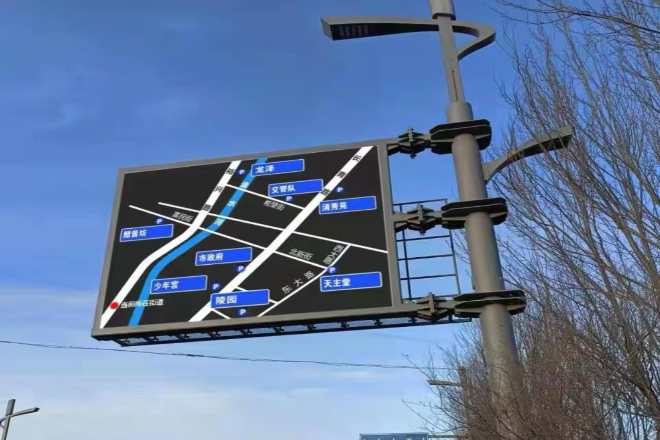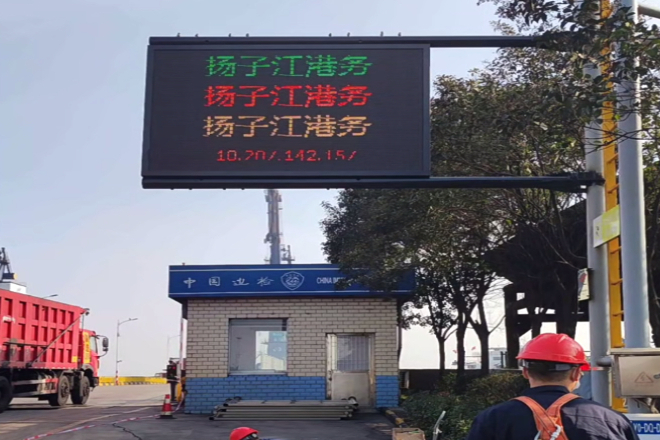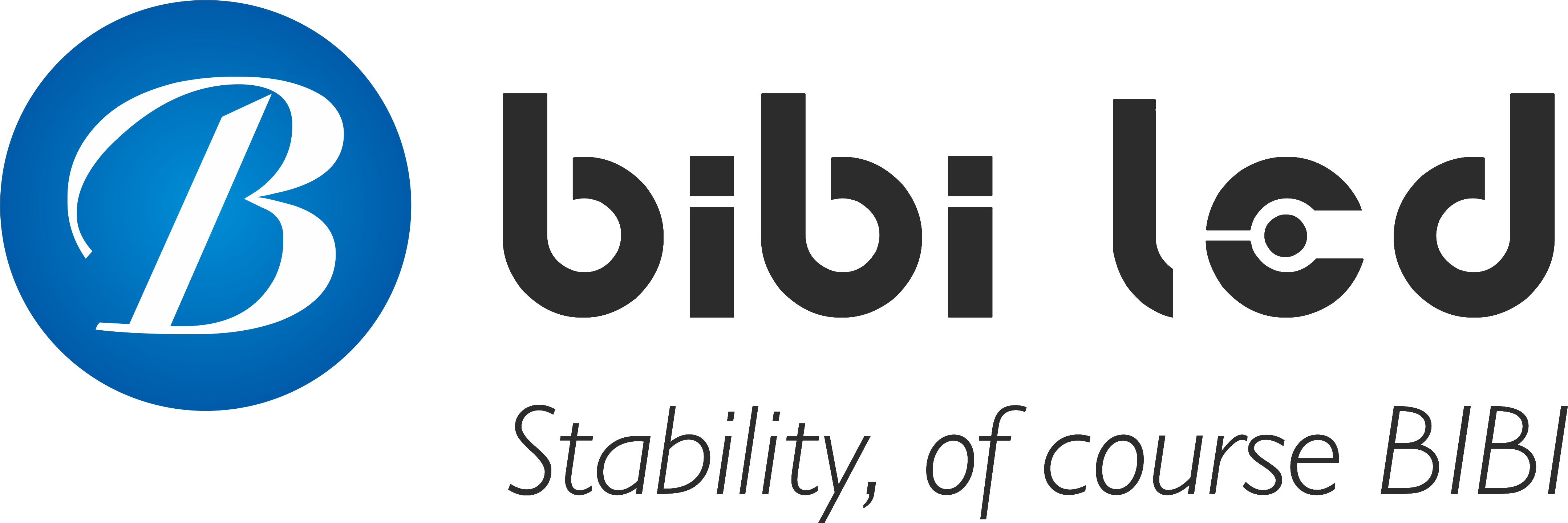Introduction

Have you ever noticed the flashing traffic induction screens on the roadside? They always convey road information in a concise and clear way, while most induction screens choose three-color displays.
What kind of mystery is hidden behind this? Why do traffic induction Afficheurs LED favor three-color design so much?
Table des matières
1. What is a three-color LED display?
A three-color LED display is an LED display that can display three basic colors.
The reason is that the LED display itself is a customized product, and the same is true for the three-color LED display.
So, these three colors can be any existing colors and can be customized by the user.
Through the combination of these three colors, a variety of different colors can be produced, thereby achieving rich display effects.
It is widely used in various display fields, such as écrans publicitaires, organiser background screens, traffic induction screens, etc.
The traffic induction LED display is a display device specifically used for traffic management.
It is usually installed along the road or at traffic nodes to provide drivers with real-time traffic information, such as road conditions, speed limits, accident information, etc.
2. What are the requirements of the traffic induction system for the display?

The traffic guidance display screen should be clearly visible under various lighting conditions.
When the sun is shining directly during the day, the screen should be bright enough for the driver to see the information on it clearly.
At night or on cloudy days, it should not be too glaring. Otherwise, it will dazzle the driver’s eyes.
The three-color LED display screen is quite suitable. It has high luminosité and can automatically adjust according to the environment, so it will not become a “bulb” at night.
Moreover, it must be able to display various texts, numbers, and symbols, just like the road signs we usually see. The content must be accurate and clear, and there must be no blur or ghosting.
If there are some dynamic effects, such as a scrolling display or gradient display, it would be even better so that the information can be more eye-catching.
The traffic guidance display screen cannot be a “rigid” thing, and it must be able to update information at any time.
For example, if the traffic conditions change or an accident occurs, the control center must be able to remotely update the content of the display screen through the network immediately without going to the scene to operate.
Moreover, it is best to be able to be operated manually locally, for example, when there is a problem with the control center network, the on-site staff can also quickly adjust the information.
In addition, the brightness adjustment of the screen is also very important. It cannot be always the same brightness, otherwise it will be too dark during the day and too bright at night.
It is best to be able to adjust it automatically according to the light, or the staff can adjust it manually.
If the screen is broken, it can also automatically alarm and tell the problem to the control center, so that the maintenance personnel can repair it in time without delay.
Most traffic guidance display screens are installed outdoors, and wind, rain, sun and rain are common, so it must be strong enough.
Waterproof and dustproof are basic requirements, otherwise the screen will easily break down in a heavy rain or sandstorm.
Moreover, it must be able to withstand severe cold and heat and can work normally from dozens of degrees below zero to high temperatures.
Its life must also be long, and it cannot frequently have problems after a short period of use.
For example, the LEDs on the screen should be durable enough, with only a few broken in a year.
The average trouble-free time of the entire screen should be as high as tens of thousands of hours, so that it does not need frequent maintenance and affect the display of traffic information.
Nowadays, information security is very important, and traffic guidance display screens are no exception.
It must have strict equipment registration and authentication functions to prevent unauthorized people from changing information at will, such as preventing people from playing pranks or maliciously tampering with traffic information.
Moreover, its various interfaces (such as USB and network interfaces) must also be strictly managed, and you cannot just plug in a USB flash drive to download things to prevent viruses or hacker attacks.
The control cabinet must also have a door lock to prevent it from being opened casually, and the data and equipment inside must be able to be remotely monitored and managed so that problems can be discovered and handled in time.
Although the traffic guidance display screen is mainly used to display information, its appearance cannot be too ugly. Its corners must be smooth and free of burrs. Otherwise, it may hurt people.
It should also be convenient to install. It is best to install it directly on the roadside pillars, and the height should be appropriate so as not to affect pedestrians.
In short, it should be both practical and beautiful. The road environment should not be messy just because a display screen is installed.
3. What are the advantages of using a three-color LED display screen in traffic guidance?
1). Clear information transmission
The core of the traffic guidance screen is to allow drivers to quickly understand road conditions. The three-color LED display screen can clearly display various texts, symbols and graphics through a combination of three colors.
For example, red can be used to display important warning information, green indicates smooth traffic, and blue can be used to display some auxiliary information, such as “500 meters ahead of the gas station”.
This color combination makes the information clear at a glance, and the driver can respond quickly without having to think hard, which greatly reduces the reaction time and improves traffic efficiency.
2). Outstanding visual effect
The display effect of the three-color LED display screen is particularly good.
It has high luminosité and strong contrast. Even in the daytime with direct sunlight or in a complex lighting environment at night, the content on the screen can still be seen clearly.
Moreover, its luminous angle is well-designed, and it will not be unclear no matter which direction you look at it from.
This screen does not need to worry about missing information due to light or angle problems, allowing drivers to accurately obtain information in various situations and reduce the trouble caused by unclear vision.
3). Cost and energy consumption control
The three-color LED display screen also has advantages in cost and energy consumption. Compared with full-color display screens, the three-color screen has a simpler structure and lower cost.
Moreover, its brightness can be automatically adjusted according to the ambient light intensity, and it will not be dazzling at night like some screens, or unclear during the day.
This intelligent adjustment function can not only save energy, but also extend the service life of the screen and reduce maintenance costs.
In general, the three-color LED display screen is both practical and economical and is particularly suitable for use in places such as traffic guidance that require long-term operation.
4. Application of three-color LED display screens in traffic guidance

1). Real-time traffic condition reminder
Imagine that you drive out and there is a traffic jam in front, but you don’t know. At this time, the three-color LED display screen on the roadside can come in handy.
It can update the traffic conditions in real-time, telling you which road ahead is blocked and which road is still open.
For example, if the screen shows “Congestion ahead, please detour,” you can change the route in advance to avoid being stuck on the road.
2). Guidelines
This display can also give you directions.
For example, if you are driving in the city and suddenly don’t know where to turn, the display will show a prompt “Turn right 500 meters ahead to reach XX Road”.
Especially for some out-of-town drivers, with this display, driving is much more convenient, and there is no need to worry about getting lost.
3). Emergency “savior”
If you encounter an emergency, such as an accident or natural disaster ahead, the three-color LED display can remind you the first time.
It will show “Accident ahead, please slow down” or “Road ahead is closed, please detour.” In this way, you can prepare in advance, avoid danger, and make traffic smoother.
4). Smart and worry-free
These displays can also automatically adjust the brightness according to the light.
During the day when the sun is strong, the screen will be brighter; at night when the light is dark, the screen will be darker and will not be dazzling.
Moreover, they can be remotely controlled, and the traffic management department can update the information at any time without sending people to the site for operation, which is very convenient.
5). Not afraid of wind and rain
The three-color LED display is very strong and is not afraid of wind, rain, or sun. Whether it is raining or hot, it can work normally without worrying about breaking down.
Moreover, it has a long life and can be used for several years without worrying about frequent maintenance.
6). Improve travel experience
These displays can help drivers save a lot of time and reduce unnecessary waiting.
For example, when going to scenic spots or commercial areas, the display can also tell you the location of nearby parking lots and even prompt surrounding restaurants and entertainment venues, which improves the travel experience a lot.
7). “Partner” with intelligent transportation systems
The three-color LED display can also work with other intelligent transportation equipment.
For example, it cooperates with intelligent traffic lights and surveillance cameras to better manage traffic.
The traffic management department can use these devices to understand the road conditions in real-time and adjust the traffic light time to make traffic smoother.
In short, the three-color LED display is very useful in traffic guidance. It not only makes traffic smoother, but also makes travel safer and more convenient.
5. Conclusion
The three-color LED display has become an ideal choice in traffic guidance systems due to its clear information transmission, excellent visual effects, economical cost control and strong durability.
It not only improves the efficiency of traffic management, but also provides great convenience for our travel.
Enfin, si vous souhaitez en savoir plus sur les écrans LED, veuillez nous contacter.
